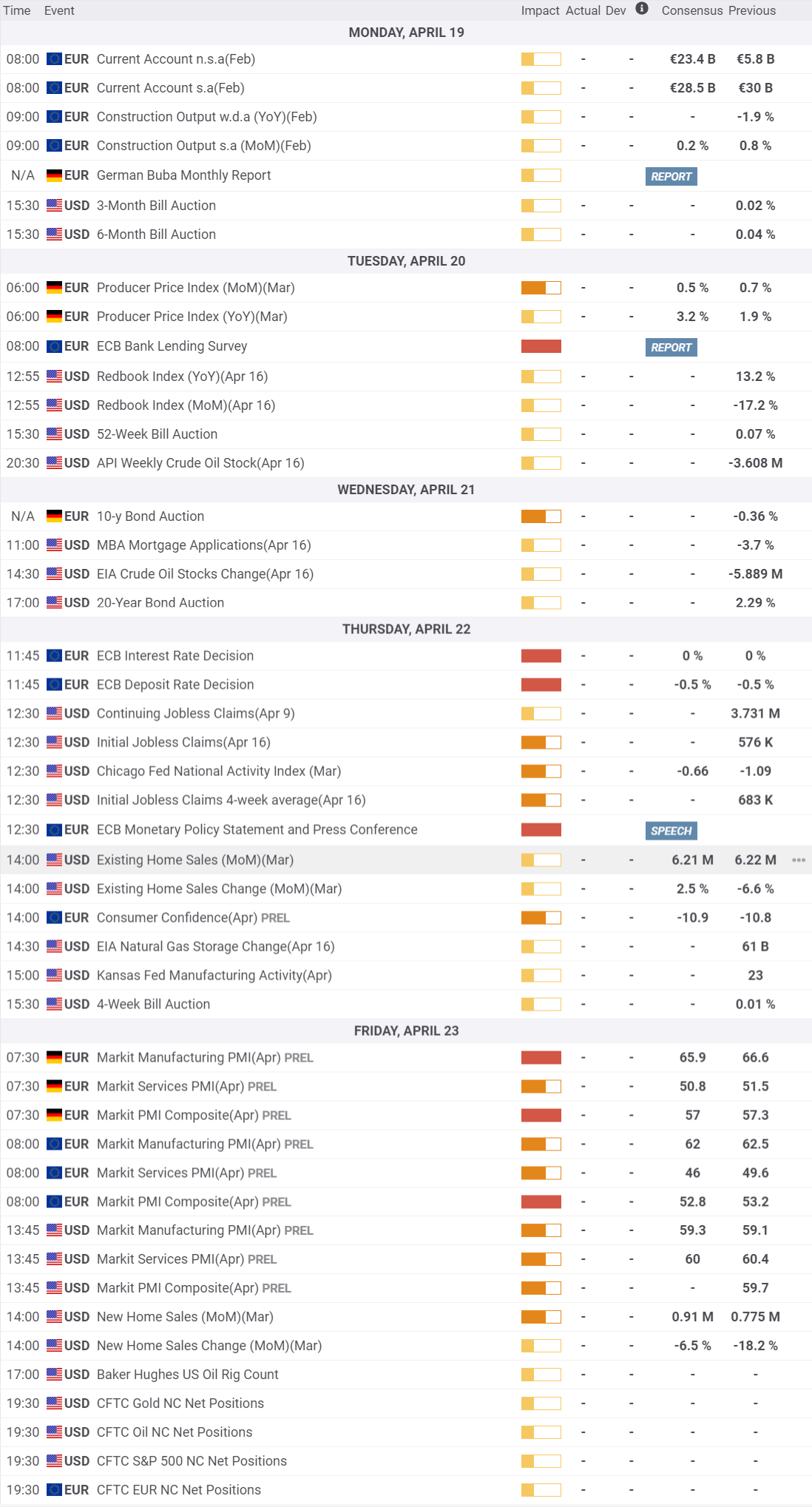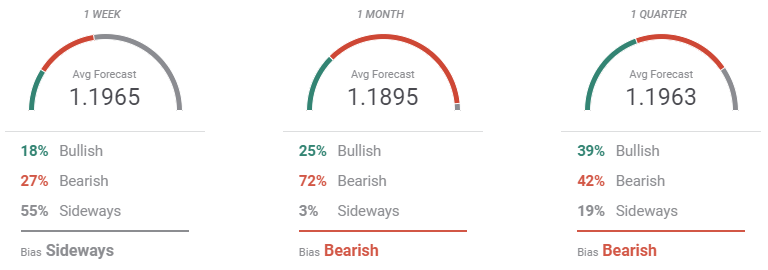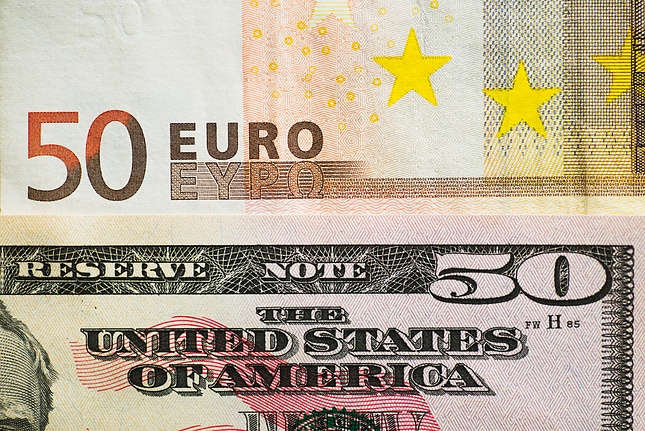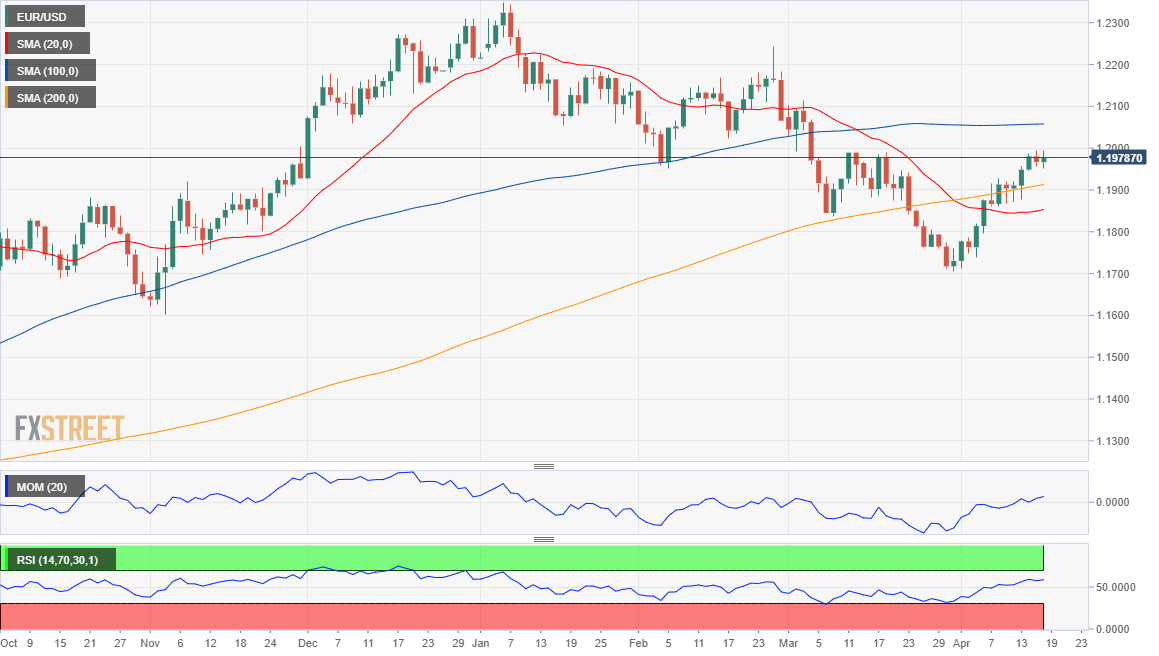- The ECB is having a monetary policy meeting next Thursday, no surprises expected.
- Cooling expectations for higher US inflation undermined bond yields and the greenback.
- EUR/USD could advance initially to 1.2060 and later surpass the 1.2100 threshold.
The EUR/USD pair hit 1.1994, its highest since March, holding nearby as the week came to an end. The broad dollar’s weakness pushed high-yielding rivals higher, with the first being a result of falling US Treasury yields.
Cold water from central bankers
US policymakers have repeated multiple times this week that the ongoing massive stimulus program will remain in place until the economy actually recovers to pre-pandemic levels. True, Fed Chair Jerome Powell and Vice-Chair Richard Clarida have hinted on the path to easing, as both mentioned tapering, although Powell made it clear that this will not happen in the near-term. However, he clarified that reducing bond-buying will become “well before” a rate hike. The Federal Reserve has been buying $80 billion in Treasuries and $40 billion in mortgage-backed securities on a monthly basis to counter the effects of the pandemic on the financial system.
Speculation that US inflation will force Fed’s hand sooner-than-anticipated cooled down, and US government bond yields fell further, with the one on the 10-year Treasury note bottoming for the week at 1.52%.
ECB’s President Christine Lagarde, on the other hand, noted that the EU economy is still suffering the echoes of the pandemic and will continue to depend on fiscal stimulus until it fully recovers. Her words came after other ECB officials suggest that the central bank may start dialling back quantitative easing as soon as July. On a positive note, Lagarde noted that the US fiscal response to the pandemic would spill over on European growth and inflation.
Economies moving in the right direction
Data wise, the EU published some encouraging figures. March inflation met expectations in Germany and the EU, still well below desired. Germany published the April ZEW survey, which showed that Economic Sentiment contracted in the month as another coronavirus wave and restrictive measures within the Union weighed on local businesses. The EU seasonally adjusted Trade Balance posted a surplus of €18.4billion, well below the previous one.
On the other hand, US data indicated constant progress. March Retail Sales jumped by 9.8%, while weekly unemployment claims contracted to 576K. The March Consumer Price Index was up 0.6% MoM and 2.6% YoY, largely surpassing the market’s expectations. On Friday, the country published the preliminary estimate of the April Michigan Consumer Confidence Index, which improved from 84.9 to 86.5, missing the expected 89.6.
Economies are moving in the right direction, but the pace of recovery is still behind the desired levels. The US is moving one step forward, for sure, but for now, it does not make a difference for the greenback. At some point, the dollar may finally react to improving macroeconomic figures, but it’s too early to tell.
For the next week, the EU has scheduled little data, although the ECB is having a monetary policy meeting on Thursday. The central bank is widely anticipated to remain on hold on monetary policy, and given Lagarde’s latest comments, it seems unlikely that European policymakers would surprise market players.
The US macroeconomic calendar will also have little to offer, as it won’t publish relevant data until Thursday, when the country will publish March Existing Home Sales and weekly unemployment figures. On Friday, Markit will release the preliminary estimates of April PMIs.

EUR/USD technical outlook
The weekly chart for the EUR/USD pair shows that the bullish potential is limited, despite the fact that the pair has advanced for a second consecutive week. Technical indicators in the mentioned time-frame, recovered from their recent lows, but the Momentum remains well below its mid-line while the RSI stands around 52. The 20 SMA is flat at around 1.2060, providing dynamic resistance should the pair advance further, while the longer moving averages also lack directional strength below the current level.
However, the EUR/USD pair is bullish according to the daily chart, with room to extend its advance. The pair has rallied this week beyond its 200 SMA, which aims north around 1.1904. The 20 SMA is directionless below it, while the 100 SMA reinforces the 1.2060 resistance level, holding a few pips above it. Meanwhile, the Momentum indicator maintains its bullish slope within positive levels while the RSI consolidates at around 58.
If the pair finally surpasses the 1.2000 mark, a run toward 1.2060 should be expected en route to the 1.2120/50 area. The downside seems limited, with the first support level at 1.1945, followed by 1.1880 and 1.1800.
EUR/USD sentiment poll
The FXStreet Forecast Poll suggest that the pair won’t be able to advance beyond the 1.2000 mark. The sentiment is neutral weekly basis, as 55% of the polled experts see it sideways, with an average target of 1.1965. In the monthly perspective, bears lead the way, representing 72% of the sample. On a quarterly basis, the bearish interest decreases but still leads. On average, the pair is seen confined to the 1.1800/1.2000 range.
The Overview chart shows a converging scenario with the sentiment, as the weekly moving average maintains its bullish stance but lacking momentum. The longer moving averages lack directional strength, although the spread of possible targets is quite tight for the one-month view, and widens to 1.15/1.24 in the longer-term perspective.

Related Forecasts:
AUD/USD Weekly Forecast: Can bulls retake the lead?
GBP/USD Weekly Forecast: Sterling's recovery hinges on top-tier UK data, further Fed speculation
Information on these pages contains forward-looking statements that involve risks and uncertainties. Markets and instruments profiled on this page are for informational purposes only and should not in any way come across as a recommendation to buy or sell in these assets. You should do your own thorough research before making any investment decisions. FXStreet does not in any way guarantee that this information is free from mistakes, errors, or material misstatements. It also does not guarantee that this information is of a timely nature. Investing in Open Markets involves a great deal of risk, including the loss of all or a portion of your investment, as well as emotional distress. All risks, losses and costs associated with investing, including total loss of principal, are your responsibility. The views and opinions expressed in this article are those of the authors and do not necessarily reflect the official policy or position of FXStreet nor its advertisers. The author will not be held responsible for information that is found at the end of links posted on this page.
If not otherwise explicitly mentioned in the body of the article, at the time of writing, the author has no position in any stock mentioned in this article and no business relationship with any company mentioned. The author has not received compensation for writing this article, other than from FXStreet.
FXStreet and the author do not provide personalized recommendations. The author makes no representations as to the accuracy, completeness, or suitability of this information. FXStreet and the author will not be liable for any errors, omissions or any losses, injuries or damages arising from this information and its display or use. Errors and omissions excepted.
The author and FXStreet are not registered investment advisors and nothing in this article is intended to be investment advice.
Recommended Content
Editors’ Picks

EUR/USD climbs above 1.0500 on persistent USD weakness
EUR/USD preserves its bullish momentum and trades above 1.0500 on Monday. In the absence of high-impact data releases, the risk-positive market atmosphere makes it difficult for the US Dollar (USD) to find demand and helps the pair push higher.

GBP/USD rises to 1.2600 area as mood improves
Following a short-lasting correction, GBP/USD regains its traction and trades at around 1.2600. The US Dollar struggles to stay resilient against its rivals as market mood improves on Monday, allowing the pair to build on its bullish weekly opening.

Gold turns bearish and could test $2,600
After recovering toward $2,700 during the European trading hours, Gold reversed its direction and dropped below $2,650. Despite falling US Treasury bond yields, easing geopolitical tensions don't allow XAU/USD to find a foothold.

Five fundamentals for the week: Fed minutes may cool Bessent boost, jobless claims, core PCE eyed Premium
Will the rally around Scott Bessent's nomination continue? The short Thanksgiving week features a busy Wednesday packed with events, and the central bank may cool the enthusiasm.

Eurozone PMI sounds the alarm about growth once more
The composite PMI dropped from 50 to 48.1, once more stressing growth concerns for the eurozone. Hard data has actually come in better than expected recently – so ahead of the December meeting, the ECB has to figure out whether this is the PMI crying wolf or whether it should take this signal seriously. We think it’s the latter.

Best Forex Brokers with Low Spreads
VERIFIED Low spreads are crucial for reducing trading costs. Explore top Forex brokers offering competitive spreads and high leverage. Compare options for EUR/USD, GBP/USD, USD/JPY, and Gold.
